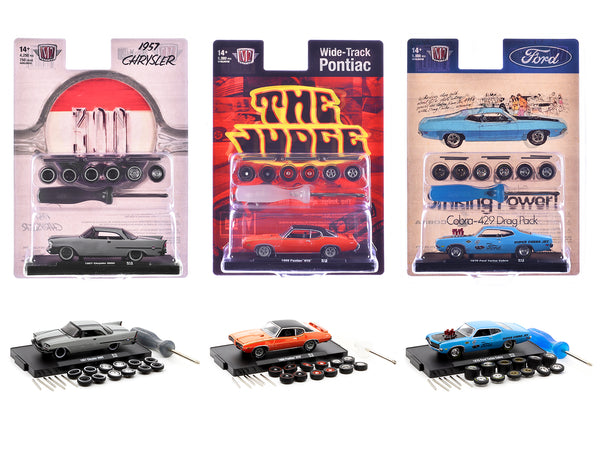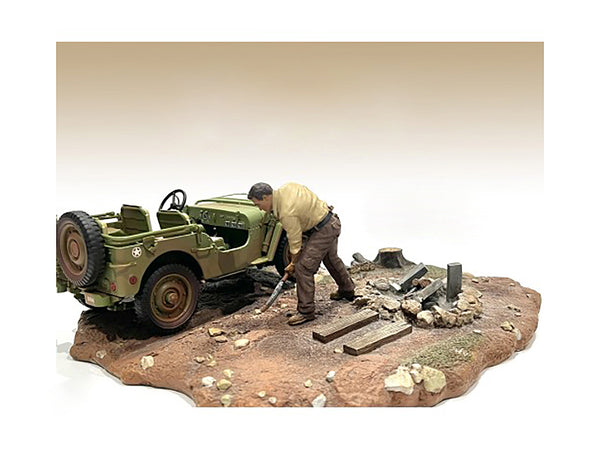
Unveiling the Ford Model Car Evolution: From Classic to Modern Designs
Related Products
Share
Tracing the Evolution of the Ford Model
From the timeless elegance of the Ford Mustang to the sleek and futuristic design of the Ford GT, the evolution of Ford's model cars has captivated the automotive world. Over the years, Ford has continuously pushed the boundaries of innovation, transforming classic designs into masterpieces of modern engineering. In this article, we will take a journey through time and explore the fascinating evolution of Ford's model cars, from their iconic vintage models to their cutting-edge contemporary designs.
Starting with the legendary Model T, often hailed as the car that revolutionized the automobile industry, Ford's early models were characterized by their simplicity, durability, and affordability. As time progressed, Ford introduced more sophisticated and stylish models, including the classic Thunderbird, known for its distinctive styling and powerful performance.
Today, Ford's lineup showcases modern masterpieces that seamlessly blend cutting-edge technology, performance, and design. From the eco-friendly Ford Fusion Hybrid to the adrenaline-inducing Ford Mustang Shelby GT500, each model in Ford's current lineup exhibits a unique blend of style, innovation, and versatility.
Join us as we delve into the rich history and evolution of Ford's model cars, uncovering the milestones and innovations that have shaped the brand's legacy in the automotive industry.
The Classic Era of Ford model cars was defined by the introduction of the iconic Model T and its successor, the Model A. The Model T, introduced in 1908, was a groundbreaking vehicle that revolutionized the automobile industry. It was the first car to be produced on an assembly line, making it affordable for the masses. With its simple yet durable design, the Model T became a symbol of innovation and freedom.
Following the success of the Model T, Ford introduced the Model A in 1927. The Model A featured a more refined design and improved performance compared to its predecessor. It was available in a variety of body styles, including sedans, coupes, and pickups, catering to the diverse needs of consumers. The Model A was a significant step forward in terms of style and comfort, setting the stage for Ford's future model cars.
The Golden Age of Ford model cars is often associated with two iconic models: the Ford Mustang and the Ford Thunderbird. Introduced in 1964, the Ford Mustang quickly became a cultural phenomenon, capturing the hearts of car enthusiasts worldwide. With its sleek and sporty design, the Mustang represented the spirit of freedom and adventure. It offered a range of powerful engines and customizable options, allowing drivers to personalize their driving experience.
In the same era, Ford also introduced the Thunderbird, a luxurious and stylish two-seater sports car. The Thunderbird featured a distinctive design with its elongated body and iconic porthole windows. It was known for its smooth ride and powerful performance, making it a favorite among those seeking both comfort and speed. The Thunderbird became a symbol of prestige and sophistication, solidifying Ford's position as a leader in automotive design.
As the automotive industry entered the new millennium, Ford continued to evolve its model car designs. The Ford Focus, introduced in 1998, marked a shift towards more compact and efficient vehicles. With its modern styling and agile handling, the Focus appealed to urban dwellers and those seeking a practical yet stylish option. It became a best-seller for Ford, showcasing the brand's commitment to innovation and adaptability.
In 2006, Ford introduced the Fusion, a midsize sedan that combined elegant design with advanced technology. The Fusion featured sleek lines and a refined interior, offering a comfortable and luxurious driving experience. It also incorporated hybrid technology, making it one of the first eco-friendly options in Ford's lineup. The Fusion represented Ford's dedication to sustainability and its ability to stay ahead of the curve in an ever-changing industry.
In recent years, Ford has continued to push the boundaries of innovation with its modern model car designs. The Ford Mustang Mach-E, introduced in 2020, is an all-electric SUV that combines the iconic Mustang styling with cutting-edge technology. With its impressive range and fast charging capabilities, the Mustang Mach-E represents Ford's commitment to a sustainable future without compromising performance.
Another standout in Ford's lineup is the Ford GT, a high-performance supercar that showcases the brand's engineering prowess. With its aerodynamic design and powerful engine, the GT offers an exhilarating driving experience. It incorporates advanced materials and technologies to maximize performance, making it a true masterpiece of modern engineering.
Throughout its history, Ford has had a profound impact on the automotive industry. The introduction of the Model T revolutionized the way cars were manufactured and made transportation more accessible to the masses. Ford's innovative assembly line techniques became the standard for the industry, allowing for increased production and lower costs.
The success of models like the Mustang and Thunderbird not only solidified Ford's position as a leading automotive brand but also influenced the entire industry. These models set new standards for design, performance, and consumer demand, inspiring other automakers to follow suit.
For car enthusiasts and collectors, Ford model cars hold a special place in their hearts. Collecting these iconic vehicles allows enthusiasts to preserve a piece of automotive history and showcase the evolution of Ford's designs. Here are a few tips for those interested in starting their own Ford model car collection:
1. Research and educate yourself about the different Ford models and their unique features. This will help you make informed decisions when purchasing and valuing your collection.
2. Attend car shows, auctions, and enthusiast events to connect with fellow collectors and learn from their experiences. Networking with other enthusiasts can provide valuable insights and opportunities to find rare or limited-edition models.
3. Look for original or well-preserved models, as they tend to hold more value over time. Authenticity and condition are key factors in determining the worth of a collectible car.
4. Consider investing in limited-edition or special edition models, as they often appreciate in value. These models typically have unique features or design elements that make them highly sought after by collectors.
5. Take care of your collection by storing it in a suitable environment and maintaining it regularly. Proper storage and maintenance will help preserve the condition and value of your Ford model cars.
Restoring classic Ford model cars is a labor of love for many enthusiasts. It allows them to bring vintage vehicles back to their former glory and experience the thrill of driving a piece of automotive history. Here are a few steps to consider when restoring a classic Ford model car:
1. Set a clear goal and vision for the restoration project. Determine the extent of work needed and decide whether you want to restore the car to its original condition or add modern upgrades.
2. Create a detailed plan and timeline for the restoration process. This will help you stay organized and focused on completing each step of the project.
3. Gather the necessary tools, equipment, and resources for the restoration. This may include specialized tools, replacement parts, and reference materials.
4. Start with the basics, such as repairing the body, chassis, and engine. Address any rust or structural issues before moving on to cosmetic enhancements.
5. Pay attention to the authenticity and accuracy of the restoration. Use original or reproduction parts whenever possible to maintain the historical integrity of the vehicle.
6. Don't be afraid to seek help from professionals or experienced restorers. They can provide guidance, expertise, and assistance in areas where you may lack knowledge or skills.
7. Enjoy the process and take pride in the final result. Restoring a classic Ford model car is a rewarding experience that allows you to preserve automotive history and create a unique masterpiece.
For Ford model car enthusiasts, joining a car club or community is a great way to connect with like-minded individuals and share their passion for these iconic vehicles. Ford model car clubs offer a range of benefits, including:
1. Networking opportunities: Car clubs provide a platform to meet and connect with fellow enthusiasts, allowing you to share knowledge, experiences, and resources.
2. Access to events and shows: Many car clubs organize events, shows, and meetups where members can showcase their Ford model cars and engage with other enthusiasts.
3. Technical support and advice: Car clubs often have members with extensive knowledge and expertise in Ford model cars. They can offer guidance, advice, and assistance with maintenance, restoration, and modifications.
4. Exclusive discounts and resources: Some car clubs have partnerships with suppliers, manufacturers, and service providers, offering members access to exclusive discounts and resources.
5. Sense of community and camaraderie: Joining a car club allows you to become part of a community of individuals who share your passion for Ford model cars. It provides a sense of belonging and camaraderie among enthusiasts.
Ford's model cars have left an indelible mark on the automotive industry, shaping its history and captivating generations of car enthusiasts. From the groundbreaking Model T to the modern and innovative Mustang Mach-E, Ford's model cars continue to push the boundaries of design, performance, and technology.
The evolution of Ford's model cars reflects the brand's commitment to innovation and adaptability. Each new generation builds upon the success and heritage of its predecessors, while embracing the latest trends and advancements in the industry. Ford's legacy in the automotive world is a testament to its ability to evolve and stay relevant in an ever-changing landscape.
Whether you're a collector, enthusiast, or simply appreciate the beauty and craftsmanship of Ford model cars, their timeless appeal and enduring legacy will continue to inspire and captivate for years to come. So buckle up and enjoy the ride as Ford continues to unveil new masterpieces that redefine the future of automotive design.
The Ford Model, a name synonymous with America's automotive history, has experienced significant transformations over the decades. The first part of our series traces its humble beginnings, from the Model T's launch in 1908 to its rapid popularity during the early 20th century.
Our second part delves into post-war America, examining how the Ford Model adapted to cultural shifts, technological advancements, and market changes. We look at pivotal models, like the Ford Mustang and Ford Explorer, that represent milestones in the Model's evolution.
In the final part, we spotlight the Ford Model's modern incarnations, discussing how current designs echo the brand's heritage while embracing future trends. We examine how the Ford Model continues to influence the global auto industry, solidifying its status as an enduring icon.





